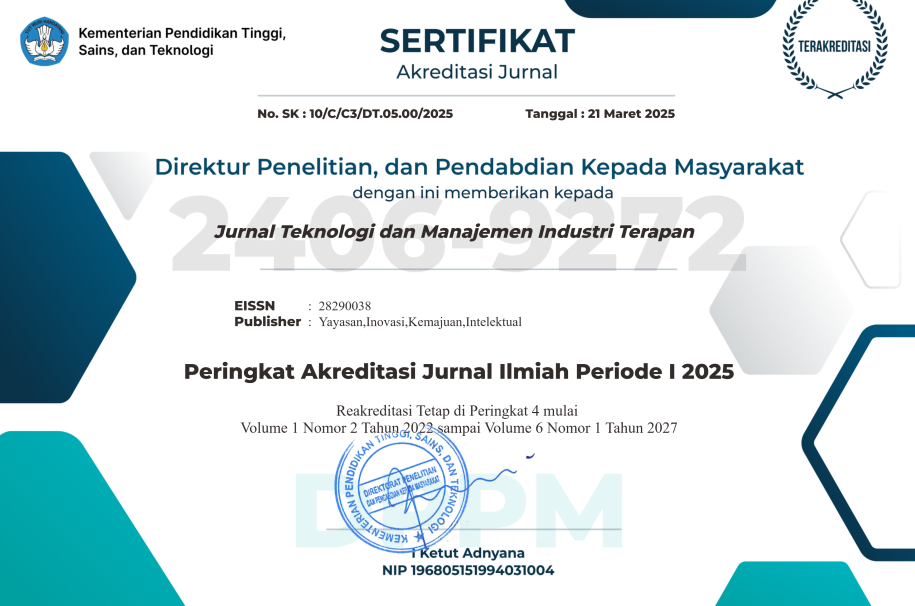Analisis Faktor Penyebab Kelelahan pada Pekerja Kontruksi Outdoor dan Indoor yang dapat Mempengaruhi Kinerja dan Keselamatan Kerja
DOI:
https://doi.org/10.55826/jtmit.v4i2.839Keywords:
Kelelahan Kerja, Pekerja Konstruksi, Pengukuran Kelelahan, Faktor Lingkungan, Kesehatan PekerjaAbstract
Industri konstruksi di Indonesia menghadapi masalah serius terkait keselamatan dan kesehatan kerja (K3), dengan sektor konstruksi menyumbang 63,6% dari total kecelakaan kerja nasional menurut data BPJS Ketenagakerjaan pada tahun 2022. Kelelahan fisik pekerja, yang disebabkan oleh beban kerja berat serta faktor lingkungan seperti suhu ekstrem, pencahayaan, dan kebisingan berkontribusi signifikan terhadap tingginya angka kecelakaan. Oleh karena itu, pengelolaan kelelahan kerja menjadi kunci penting dalam menurunkan angka kecelakaan dan meningkatkan keselamatan pekerja di sektor konstruksi. Penelitian ini bertujuan untuk menganalisis pengaruh faktor-faktor lingkungan kerja dan karakteristik individu terhadap tingkat kelelahan kerja pada pekerja konstruksi serta mengidentifikasi faktor yang paling berpengaruh dalam kelelahan kerja. Penelitian ini menggunakan pendekatan cross-sectional yang melibatkan 81 pekerja berusia antara 20 hingga 50 tahun. Variabel bebas dalam penelitian ini adalah faktor-faktor fisik lingkungan kerja yang diukur menggunakan Wet Bulb Globe Temperature (WBGT) dan 4-in-1 Environment Meter, sementara variabel terikatnya adalah kelelahan kerja yang diukur melalui kuesioner International Fatigue Research Committee dan pengujian waktu reaksi. Berdasarkan hasil analisis regresi logistik, beberapa variabel yang mempengaruhi kelelahan kerja dapat diidentifikasi baik pada kondisi outdoor maupun indoor. Pada pekerja outdoor, dua variabel yang berpengaruh signifikan adalah Indeks Massa Tubuh (IMT) dengan nilai p = 0,022 dan Temperatur dengan nilai p = 0,026. Sementara pada kondisi indoor, Intensitas Kebisingan menunjukkan pengaruh signifikan dengan nilai p = 0,039. Variabel lainnya seperti usia, lama kerja, intensitas cahaya, dan beban kerja tidak menunjukkan pengaruh signifikan pada kedua kondisi tersebut.
References
B. Kim et al., “Internet of things and ensemble learning-based mental and physical fatigue monitoring for smart construction sites,” J. Big Data, vol. 11, no. 1, 2024, doi: 10.1186/s40537-024-00978-7.
W. Yi, H. Zong, M. F. Antwi-Afari, and A. P. C. Chan, “Determining the optimal recovery time for fatigued construction workers: Machine learning approach based on physiological and environmental measurements,” Build. Environ., vol. 275, no. February, p. 112808, 2025, doi: 10.1016/j.buildenv.2025.112808.
C. J. Knüsel and E. M. J. Schotsmans, The Routledge Handbook of Archaeothanatology. 2022. doi: 10.4324/9781351030625.
W. Liu, Q. Meng, Z. Li, H. Y. Chong, K. Li, and H. Tang, “Linking organizational safety support and construction workers’ safety behavior: the roles of safety motivation, emotional exhaustion and psychosocial safety climate,” Eng. Constr. Archit. Manag., 2024, doi: 10.1108/ECAM-02-2024-0182.
C. DeLong and C. Marudo, “Boiling point: the health risks of heat protection restrictions for agriculture and construction workers,” Front. Public Heal., vol. 12, 2024, doi: 10.3389/fpubh.2024.1484975.
R. Ameliawati, “Penerapan Keselamatan dan Kesehatan Kerja dengan Metode HIRADC (Hazard Identification, Risk Assessment and Determining Control) di Area Plant-Warehouse Implementation of Occupational Safety and Health with The HIRADC (Hazard Identification, Risk Assessmen,” Rang Tek. J., vol. 6, no. 1, pp. 51–64, 2022.
R. J. Bangonang, W. B. S. Joseph, and F. L. F. Langi, “Analisis dan Prediksi Tren Kecelakaan Kerja di Indonesia,” J. Lentera Penelit. dan Pengabdi. Masy., vol. 3, no. 2, pp. 75–78, 2022.
Suma’mur PK, Higiene Perusahaan dan Kesehatan Kerja (Hiperkes). Jakarta: CV Sagung Seto, 2009.
Setyawati L, Selintas Tentang Kelelahan Kerja. Yogyakarta: Amara Books, 2010.
A. K. Mahi, Survei Tanah; Evaluasi dan Perencanaan Pengunaan Lahan Edisi 2. Graha Ilmu, 2015.
A. E. Dembe, J. B. Erickson, R. G. Delbos, and S. M. Banks, “The impact of overtime and long work hours on occupational injuries and illnesses: New evidence from the United States,” Occup. Environ. Med., vol. 62, no. 9, pp. 588–597, 2005, doi: 10.1136/oem.2004.016667.
A. Kjellberg, “Fatigue after work in noise - an epidemiological survey study and three quasi-experimental field studies,” Noise Heal. J., vol. 1 (1), pp. 45–55, 1998.
C. O’Neill and K. Panuwatwanich, “the Impact of Fatigue on Labour Productivity: Case Study of Dam Construction Project in Queensland,” no. October 2013, pp. 993–1005, 2013, doi: 10.32738/ceppm.201310.0095.
T. S. Abdelhamid and J. G. Everett, “Physiological Demands during Construction Work,” J. Constr. Eng. Manag., vol. 128, no. 5, pp. 427–437, 2002, doi: 10.1061/(asce)0733-9364(2002)128:5(427).
work safe victoria, “Fatigue prevention in the workplace,” 2008.
M. I. 2007. Ramdan, “Dampak Giliran Kerja, Suhu dan Kebisingan terhadap Perasaan Kelelahan Kerja di PT LJP Provinsi Kalimantan Timur. The Indonesian Journal of Public Health,Volume 4 Nomor 1, Juli 2007,” vol. 4, no. 1, pp. 8–13, 2007.
W. Yi and A. P. C. Chan, “Optimal Work Pattern for Construction Workers in Hot Weather: A Case Study in Hong Kong,” J. Comput. Civ. Eng., vol. 29, no. 5, pp. 1–11, 2015, doi: 10.1061/(asce)cp.1943-5487.0000419.
I. Morioka, N. Miyai, and K. Miyashita, “Hot environment and health problems of outdoor workers at a construction site,” Ind. Health, vol. 44, no. 3, pp. 474–480, 2006, doi: 10.2486/indhealth.44.474.
N. S. Seixas et al., “10-Year prospective study of noise exposure and hearing damage among construction workers,” Occup. Environ. Med., vol. 69, no. 9, pp. 643–650, 2012, doi: 10.1136/oemed-2011-100578.
Ruliati, “Hubungan Stres Kerja, Suhu Di Ruang Kerja, dan Kadar Hb Terhadap Kelelahan Kerja Pegawai Di Instalasi Binatu RS Dr. Sardjito Yogyakarta,” Tesis Univ. Gdjah Mada, 2006.
J. T. Spector et al., “Associations between heat exposure, vigilance, and balance performance in summer tree fruit harvesters,” Appl. Ergon., vol. 67, pp. 1–8, 2018, doi: 10.1016/j.apergo.2017.09.002.
J. Oh, F. Chung, C. Koo, D. Castro-Lacouture, and B. Ashuri, “Empirical adaption of Work/Rest schedules to physiological variability in heat response,” Saf. Sci., vol. 177, no. November 2023, p. 106574, 2024, doi: 10.1016/j.ssci.2024.106574.
J. Yang, G. Ye, Z. Zhang, X. Liu, and Y. Liu, “Linking construction noise to worker safety behavior: The role of negative emotion and regulatory focus,” Saf. Sci., vol. 162, no. 174, p. 106093, 2023, doi: 10.1016/j.ssci.2023.106093.
A. Shkembi, L. M. Smith, A. B. Le, and R. L. Neitzel, “Noise exposure and mental workload: Evaluating the role of multiple noise exposure metrics among surface miners in the US Midwest,” Appl. Ergon., vol. 103, no. March, p. 103772, 2022, doi: 10.1016/j.apergo.2022.103772.
Downloads
Published
Issue
Section
License
Copyright (c) 2025 Charlos Malino, Suharyanto

This work is licensed under a Creative Commons Attribution-NonCommercial-ShareAlike 4.0 International License.


















